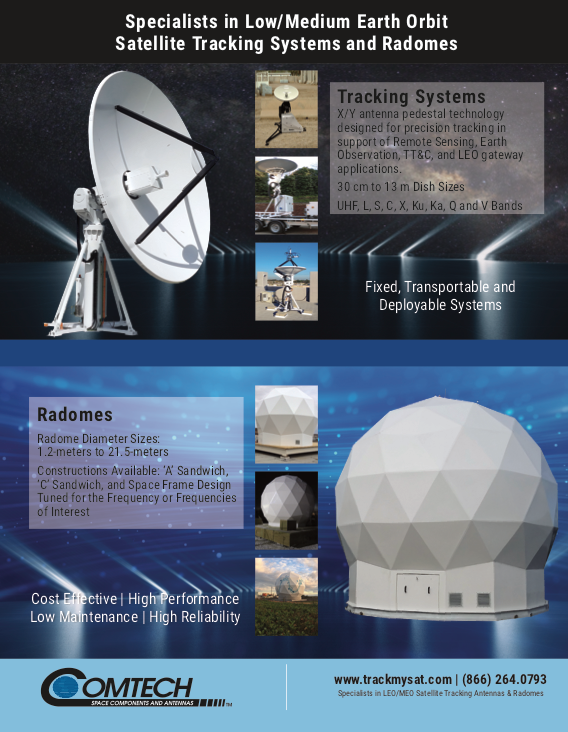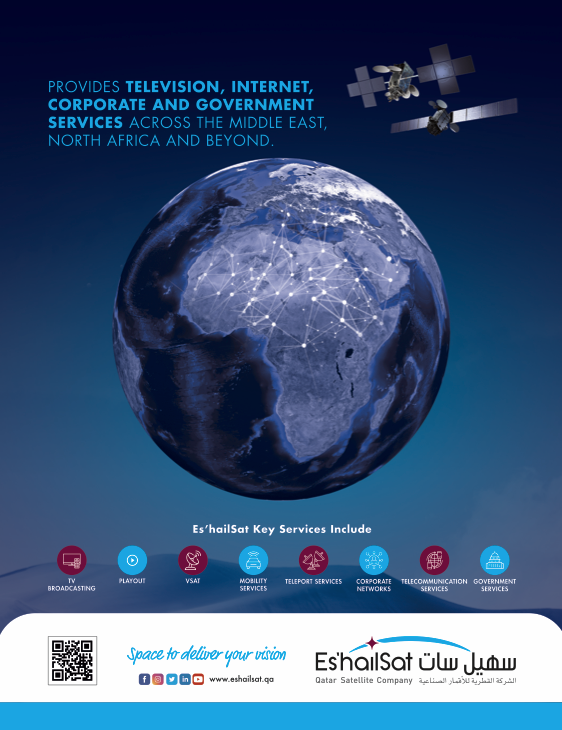Software-Defined Satellites, New Business Cases and Massive Growth Opportunities

John Gilroy, Host, Constellations
Welcome to Constellations, the podcast from Kratos. Our guest is Dallas Kasaboski, consultant with Northern Sky Research, co-author of the recent NSR report “Software Defined Satellites.” To start, Dallas, please clarify what it means for satellites to be software-defined?

Dallas Kasaboski
We hear the term a lot and the simplest definition is a satellite that can be changed or adapted driven by software. Most satellites that go up have a mission, and some flexibility in their capabilities. But for a satellite to be software-defined, it must be able to upload new software and have it completely change its operation. So, to be able to change your satellite’s mission using new software means is why its referred to as software-defined.
Data centers like Microsoft and Amazon do updates remotely all the time. So, this doesn’t seem a groundbreaking concept, although it does seem new in the satellite world. Is a software-defined satellite just applying what’s worked consistently on earth to different types of hardware? And, what demand are we seeing for software-defined satellites in GEO and non-GEO?
Dallas Kasaboski
Making those changes in space is challenging. You’re not there, and there’s lots of other considerations. So, yes, in one way, this is satellites catching up to the terrestrial space. In the communication space, for example, there are specific requirements for a satellite to be software-defined. Communication satellites in GEO are usually fixed, they have wide or spot beams that are focusing on one area of the earth. One aspect of software-defined satellites is that they can steer those beams. They also have a digital channelizer, an ability to cut the beam up, reprioritize it, refocus it in a different way. And the third is that they have some ability to change their onboard power or spectrum.
This goes to the question about demand. GEO satellites are just beginning to engage in software-defined satellite architectures, mostly for the additional levels of flexibility they provide. A common use case might be that you’ve been selling video services through satellite for years, but with that market shifting or decreasing you want the ability to shift to another type of application in the future. So, we’re seeing that as a growing use case. GEO is roughly split 50/50 between traditional bent pipe, non software-defined which is not that flexible, versus something that has flexibility, whether steerable beams all the way down to power and spectrum configuration, digital channelization, and so on.
In non-GEO, the story is very different. Being able to steer beams is almost 100% a requirement. Depending on your network configuration, you may be able to get by without steering beams, but it’s really inefficient. These satellites are moving very quickly, they need to coordinate, they need to change their look angle depending on the horizon. So, steerable beams is almost a prerequisite, which means that most non-GEO satellites are some level software-defined by definition.
There’s only a few players that are really going full flexible, but it’s growing. As we see it about 95% of all satellites that are going to be ordered in the next decade, will have some level of flexibility.
Is video the one application that’ll benefit the most from these new types of satellites?
Dallas Kasaboski
Yes, that’s one that a lot of GEO operators quote, is the potential need to shift from video to another application. Video has brought a lot of revenue generation in GEO over the years, but that market is changing and many are moving toward a more data-centric focus. So that ability to pivot is the use case.
Another use case, which could work for many applications, including broadband, backhaul, and mobility, is this ability to not only steer beams, but reconfigure them. So, you might have a GEO satellite in one area, but you see that your traffic patterns are changing seasonally or even daily. And if you had a more software-defined satellite, you might be able to redistribute the spectrum to make the most use of it so you’re not blanketing an area that doesn’t need it. So, there’s great need in these cases for flexibility and different efficiencies, whether it’s cost or performance.

How will these new software-defined satellite capabilities impact the ground segment?
Dallas Kasaboski
A lot. We often call the ground segment the forgotten link of the satellite network, because often everyone is so excited about manufacturing hardware, different funding and investment, that the ground often lags behind. That is changing. We’re seeing a push- pull trade off. On the one hand, satellites are becoming more flexible and capable, with greater flexibility within their network management. But on the other hand, managing that network on the ground is more complicated. The satellite is smarter, more flexible, but more complex, which requires more effort on both the hardware and software side.
Talk about 5G. What role will that play in these software-defined satellites?
Dallas Kasaboski
Yes, 5G is going to affect every part of the system. In general, 5G is both hardware and a network protocol that needs to be considered. So, if you want your satellites to be compatible with 5G, then they have to speak that protocol and potentially be 5G enabled or have compatible hardware onboard. So any software-defined satellite for applications like backhaul, broadband, mobility, should be paying attention to 5G in terms of how to better integrate it. If the goal with software-defined satellites is to be more flexible and capable, those new capabilities will mean less if they’re not interoperable or integrated into other networks like terrestrial and cellular. You can stand on your own as a software-defined satellite, but 5G is a way to bring these networks together. That’s where we see the impact.
Operators, the ground network, the manufacturers, they’re all working more closely together to make systems that are capable of communicating efficiently with each other and reconfigure at the same pace. And that’s how 5G is going to impact software-defined satellites and vice versa.
How do software-defined capabilities affect pricing and performance?
Dallas Kasaboski
In short, hardware costs are going down, and software costs are going up. The strategy of manufacturers is to create a more software capable satellite, and one of the ways of doing that is by standardizing the hardware, shifting the complexity of the satellite from the hardware to the software. And in some cases, the hardware costs have gone down, and as I said, the software costs have gone up. But in terms of the overall satellite, software- defined satellites can be cheaper in many cases.
There are other factors. Basically, if you go from a completely bent pipe traditional satellite to a software-defined satellite, there’s usually a price increase because it’s a more capable system, and it’s a newer architecture. Once you look at the difference between partial and full flexibility, we’ve seen cases where fully flexible satellites have come out cheaper than partially flexible satellites. That’s a result of a lot of different factors, but mostly through standardization of the hardware and the growing but not outpacing costs of the software.
Who are the early adopters and how are they using it?
Dallas Kasaboski
The familiar ones are the operators, like SES. SES-17 is a very flexible satellite constructed by Boeing. Intelsat has ordered software-defined satellites. Some GEO players are really jumping on board early. And we’ve seen some from Eutelsat and Inmarsat as well, as they all see the need for flexibility in space.
Maybe you don’t handle that on the satellite itself, maybe you handle that on the ground, or you do it through 5G protocols or something. But generally speaking, the capability is growing in satellites, and some of these operators are either taking risks or they’re trying to mitigate risks by having some bridging solution like we talked about earlier.
How is this looking regionally?
Dallas Kasaboski
Regionally, it’s probably no surprise we’re seeing a lot of interest from North America, and more orders from Europe and Asia. Those three areas dominate. And we’re seeing more orders coming from those areas for different levels of flexibility. Those regions have operators who may be ready to invest in another generation of satellites or maybe they have networks that are more complicated that need bridging, or maybe they have the funding to be able to afford it. But it goes back to greater need for flexibility.
Some operators in middle east or in Latin America, for example, are satisfied with a traditional bent pipe solution. They’re generally cheaper and they work very well. And maybe their needs for flexibility aren’t substantial. One operator in Asia who was considering a software defined satellite decided to go with bent pipe because the technology wasn’t quite there yet, and they believed that they could get a bent pipe satellite manufactured more quickly than a software defined one. So the reasons come down to technology or requirement, timing, and business strategy.
Can you project eight to 10 years ahead and how the satellite industry will have changed because of these new capabilities?
Dallas Kasaboski
Looking ahead is always a balance between what has been done and innovation. We look to what the markets have been ordering and how certain markets have adapted to new technology, their adoption, their willingness to switch, the cost of adoption, and how disruptive or innovative that technology will be, how easy is it to adopt. We’ve talked about the great capabilities of software-defined satellites, but there’s a reason that it’s still 50/50 in GEO, in terms of who’s ordering bent pipe versus who’s ordering software-defined. And the reason is because its expensive and it is challenging to integrate these new capabilities into your system. It’s not always plug and play.
Going forward, we see GEO shifting toward software-defined, but not fully. Most of the orders we predict, will be in the partially defined, which means that they have one, but not all of those capabilities I mentioned earlier. Steerable beams, for example, is the low hanging fruit of software-defined satellites.
An operator who wishes to maybe be able to change the direction of their spectrum based on different market changes, they might go for a bent pipe plus steerable beams that have a slightly partial satellite. In non-GEO, we also see partial flexibility as the key. And the reason is that a lot of players don’t need full flexibility, especially for a constellation that they’re going to have to replenish in five or seven or 10 years.
So, what they do is they make them as sophisticated as possible without going over the top because they know they’re going to have to spend that CapEx in another five or seven years. So partial flexibility is where we see the market shifting to, and the majority of orders we see over the next 10 years to be placed there.
Dallas, thank you articulating what can be abstract concepts, and explaining software-defined satellites.
Want to hear from more thought leaders? Listen to Constellations podcasts as they become available.
See the full list of interviews and subscribe at: www.constellationspodcast.com



